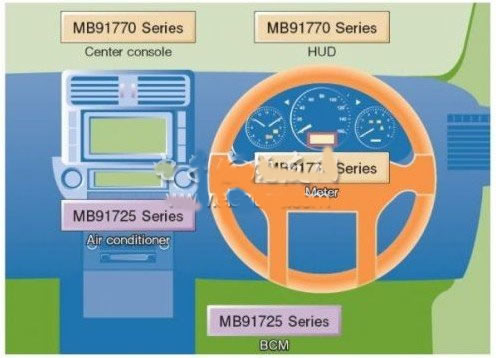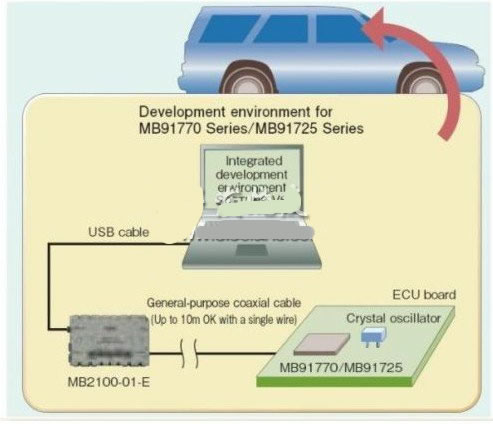introduction This article refers to the address: http:// In today's car design, people pay more and more attention to the two aspects of intelligence and environmental protection. Because intelligent cars can bring people a high degree of safety and comfort, in terms of environmental protection, energy conservation and carbon saving are achieved through the use of digital technology. As a result, the degree of digitization is deepening in the automotive field, ranging from powertrain systems to in-vehicle entertainment systems, where electronic components are everywhere, and they are widely used in sensing and control. In the various systems of automotive electronics, it is often necessary to use a microcontroller (MCU) as the core of operational control, and the dependence of the car on the electronic system also stimulates the rapid growth of the automotive microcontroller market. The vehicle's microcontrollers cover low, medium and high-end product grades such as 8-bit, 16-bit and 32-bit, each with its own suitable application system, which is roughly as follows: 8-bit MCU: Mainly used in various subsystems of the car body, including fan control, air conditioning control, wiper, sunroof, window lift, low-end instrument panel, junction box, seat control, door control module, etc. control function. 16-bit MCU: Mainly used in powertrain systems such as engine control, gear and clutch control, and electronic turbine systems; also suitable for chassis mechanisms such as suspension systems, electronic power steering, torque dispersion control, and Electronic pump, electronic brakes, etc. 32-bit MCUs: Main applications include dashboard control, body control, multimedia information systems (TelemaTIcs), engine control, and emerging intelligent and real-time security systems and power systems such as Pre-Crash, Adaptive Safety functions such as cruise control (ACC), driver assistance system, electronic stability program, and complex X-by-wire transmission functions. 1 common interface for vehicle MCU CAN and LIN are the more common interfaces. With the ever-increasing demands of today's automotive applications, the systems that need to be integrated are becoming more and more complex, making the demand for high-end 32-bit MCUs in automotive electronic systems increasing. Such MCUs for vehicles are often placed in a high-heat, dusty, shock, and electronically disturbed operating environment, so the tolerance requirements are much higher than general-purpose MCUs. In addition, in automotive applications, automotive MCUs must be connected to multiple automotive electronic control units (ECUs), the most common of which are CAN and LIN. CAN is divided into high-speed CAN and low-speed CAN. The transmission rate of high-speed CAN can reach 1 Mbps. It is suitable for applications that emphasize real-time response such as ABS and EMS. Low-speed CAN can reach 125 Kbps, which is suitable for lower-speed car body parts control. In addition, the CAN controller can be divided into the old 1.x, the standard 2.0A and the extended 2.0B. The newer specifications are naturally better, and the 2.0B can be divided into passive and Active type. LIN is a lower speed and lower cost communication scheme than CAN. It adopts the concept of one master node and multiple slave nodes (up to 16 nodes), up to 20 kbps data transmission rate, and the length of bus cable can be extended up to 40 meters. It is ideal for Climate Control, Mirrors, Door Modules, Seats, Smart Switches, Low-cost Sensors A distributed communication solution that is simpler than a simple system. The following is a description of the next-generation MCU technology applied to instrument panel control and body control, and is based on Fujitsu's new MB91770 series and MB91725 series of new microcontrollers. Please refer to (Figure 1). Figure 1 Dock control and body control MCU in the car (take MB91770 series and MB91725 series as an example) 2 Automotive dashboard and body control design essentials The dashboard of the car provides a variety of real-time visual information for driving. This information is an important reference for assisting decision making and must be communicated to the driver quickly and accurately. In addition, the air conditioning and body control module (BCM) system in the car is responsible for providing a comfortable ride environment for driving and passengers. Among them, the air conditioning system performs optimal control to quickly reduce the temperature inside the car to a relatively comfortable level, and maintains a comfortable interior temperature based on information from various sensors. The BCM system can centrally control multiple ECUs such as doors, seats and combination switches. MCUs, whether dashboard control or body control, must provide higher processing performance, the ability to handle large numbers of network nodes, interface functions that support multiple peripheral connections, expandable board layout range, and advanced memory architecture. And a more convenient development environment. 2.1 High processing performance To improve processing performance, MCUs must take the FR81S CPU core of Fujitsu's next-generation MCU from its core and software and hardware system architecture as an example. Its working performance reaches 1.3MIPS/MHz, which is 30% higher than the previous generation FR60 core. Performance; with built-in single-precision floating-point arithmetic unit (FPU), it can meet the requirements of image processing systems and systems that require floating-point operation (such as brake control). In addition, hardware FPU support simplifies software programs and improves computing performance. 2.2 A large number of network node processing capabilities There are a large number of built-in ECUs in the CAN network in today's cars. Their size has been increasing with the number of nodes, so the car MCU must support more message buffers. The previous generation of 32-bit CAN microcontrollers can provide up to 32 built-in message buffers, but now it is not enough. With the new generation of Fujitsu MCUs, it can support up to 64 built-in message buffers, and support CAN 2.0A/B specification and high transmission rate of 1Mbps. 2.3 Broad interface support capabilities The periphery of the car MCU connection is quite diverse, and the connected interface may be UART, frequency synchronous serial, LIN-UART and I2C, so it must have flexible interface connection capability. In order to meet this demand, Fujitsu uses the built-in multi-function serial interface as a serial communication interface, and switches the above various interfaces through software to flexibly support the communication specifications of external components and improve the freedom of system design. The new family of MCUs also offers six channels of LIN-UART for communication with more control units; the MB91725 series is easier to integrate with various functions due to multiple channels and A/D converters with timer function. . Please refer to (Figure 2). Figure 2: Using the serial interface to achieve flexible communication interface function integration 2.4 Expandable board layout range features Since the layout design of the vehicle circuit board system is quite diverse, the vehicle MCU must be able to meet the needs of these designs. Some possible practices include configuring an independent power supply for the external bus interface terminals so that no level shifters need to be installed on the ECU board. This external bus interface terminal has a wide power supply range (eg, covering 3.0V to 5.5V), and can be flexibly connected to the unit memory or image ASIC. Another way is to let the MCU have the built-in I/O redistribution function, and the I/O port can be changed through software settings. In this way, the designer can be more flexibly connected to a specific periphery, thereby greatly increasing the degree of freedom in board layout. 2.5 Advanced Memory Architecture In order to improve the flexibility of work processing, embedded memory (Flash) is often built into the system of today's automotive microcontrollers. In the past, only Flash was used for program storage, and Flash for data was added to the architecture of the new generation MCU. This architecture not only improves data write speed, but also reduces the board area by eliminating the need for E2PROM. In addition, storing data and programs in the flash memory of the microcontroller also helps prevent information leakage. 2.6 More convenient development environment General products must use the ICE main unit and verification evaluation chip for system verification. In order to reduce the complexity of verification, we provide on-chip debugging mode for next-generation MCU products. It features a single-wire debug interface for automotive evaluation or compliance testing, and enables communication between small ICE main units and target boards up to 10 meters with universal coaxial cable. This simplifies vehicle evaluation that is difficult to achieve in routine. Figure 3 Using the on-chip debugging to achieve vehicle evaluation 3 Conclusion The use of electronic systems in automobiles is becoming more and more complex, and automotive MCUs are playing an increasingly important role. Due to the design of the car's dashboard and body control, it must be based on the premise that the driver provides accurate information and provides a comfortable ride experience. Therefore, the MCU must meet the higher performance and design requirements to help develop the application. Power Bank HUB,Hub Station 2.0,Transfer file hub USB2.0 shenzhen ns-idae technology co.,ltd , https://www.best-charger.com


MCU-based vehicle performance improvement design
Multi-Port HUB 2.0
Multi-port Hub 2.0: This multi -port hub 2.0 is very compatible: Windows XP, 7, 8, 10, 11, Vista/Mac OS X 10.2 and higher/linux/unix compatibility. Can be added to any compatible device. This multi-port hub 2.0 belt protection equipment: constructed in overvoltage/over-current/leakage and short-circuit protection unit. The built -in electric surge protector design is used to ensure that the equipment is safe without a driver.